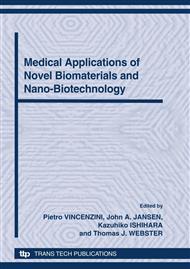p.214
p.224
p.229
p.235
p.240
p.247
p.253
p.259
p.264
Stoichiometry and Surface Stress Analyses in Advanced Alumina/Zirconia Composites for Hip Arthroplasty Applications
Abstract:
A spatially resolved cathodoluminescence (CL) analysis is used as a means for chemical and mechanical analyses of the composite surface after environmental exposure. CL emission proves extremely efficient in concurrently monitoring the concentration of point defects (e.g., oxygen vacancies) on the material surface. Using CL, averaging effects from sub-surface parts of the material can be minimized, and the actual chemical state of the material surface is revealed. As a result, information about the stoichiometry of the material surface can be obtained directly from the lattices of the constituent phases, this enabling one to pattern relevant connections to the environmental resistance of oxide-based bioceramics. A highly fracture resistant alumina/zirconia composite represents the latest trend in ceramics for arthroplastic applications in alternative to monolithic alumina or zirconia ceramics. This composite material is designed from both chemical and microstructural viewpoints in order to prevent environmental degradation and fracture events in vivo, an important step forward in the full exploitation of ceramic materials in the field of arthroplasty. Systematically monitoring the optical activity of oxygen vacancies in both alumina and zirconia phase reveals the distinct role on the kinetics of polymorphic transformation. From the presented data an explicit role is evinced for oxygen vacancy formation in the alumina matrix in the complex cascade of mechanochemical events determining the environmental resistance of the composite.
Info:
Periodical:
Pages:
240-246
Citation:
Online since:
October 2010
Price:
Сopyright:
© 2010 Trans Tech Publications Ltd. All Rights Reserved
Share:
Citation:


